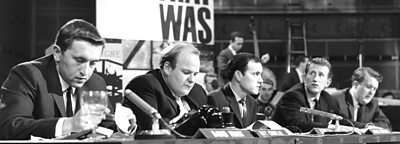In 1948, the ����ý published its now infamous ‘Green Book’, a set of guidelines for writers and producers of comedy. According to the preface, ‘Programmes must at all cost be kept free of crudities, coarseness and innuendo. Humour must be clean and untainted directly or by association with vulgarity and suggestiveness.’ On that basis, and had ����ý writers and producers stuck rigidly to these guidelines, some of the great comedy classics would never have seen the light of day.
Moreover, the guidelines went on to note ‘an absolute ban’ on jokes about lavatories, effeminacy in men, immorality of any kind, and suggestive references to the following: honeymoon couples, chambermaids, fig leaves, prostitution, ladies' underwear (e.g. winter draws on), animal habits (e.g. rabbits), lodgers, and commercial travellers. Producers also had to take ‘extreme care’ in dealing with references to or jokes about pre-natal influences (e.g. 'His mother was frightened by a donkey') and marital infidelity.
In his interview with Frank Gillard in 1984 former Assistant Head of Light Entertainment, Frank Muir, remembered how tricky it was to get risqué type of humour past one particular producer:
Not-withstanding this sometimes perplexing guidance (now consigned to the archive and superseded by more relevant editorial guidelines), the ����ý has a long tradition of comedy programming on both radio and television, entertaining its audiences and making them laugh listening to and watching situation comedies, game shows, panel shows, stand-up comedy, sketch shows, and variety. The ����ý’s Oral History Collection – together with interview material from The British Entertainment History Project – allows us to gain an insight into some of the decision-making processes and the programming discussions. It also shows that despite having to adhere to strict guidelines at times, the ����ý also pushed at the boundaries and nudged comedy and satire into new directions.
Hancock
When ITV launched in 1955, the ����ý faced competition for viewers, especially in the field of light entertainment. Turning to radio for a successful format which would attract a good television audience, , starring the eponymous Tony Hancock, was broadcast for the first time on ����ý Television on 6 July 1956.
Since its launch on radio in 1954, the situation comedy format had proved a great success and Hancock’s demeanour particularly suited television, with Hancock’s facial expressions working well on the visual medium.
Finding comedy in the seemingly ordinary everyday life of a bachelor, and developing a brand of observational humour based on a two-hander (Hancock and co-star Sid James) proved to be a hit for writers Ray Galton and Alan Simpson and producer Duncan Wood. However, as time went by, Hancock began to feel that James was attracting more attention and told Galton and Simpson to write him (Sid James) out of the show. The final series focused on Hancock only.
Then Hancock went a step further and, feeling that he was being held back in some way, sacked his writers. Former Head of Comedy at the ����ý, James Gilbert, reflected on this in an interview for the British Entertainment History Project in 1990:
Hancock’s decision to move to ITV in 1963 resulted in the show – also entitled Hancock – gaining reasonable audience figures, but critics felt that the standards attained whilst at the ����ý were never quite maintained. Nevertheless, a firm foundation had been set by Hancock, Galton, and Simpson, and the series led to other successes in ����ý situation comedy such as Steptoe and Son.
That Was The Week That Was
Whilst Hancock’s Half Hour established a framework for the television sitcom, political satire on television was given a kick-start by a relatively short-lived but influential series, That Was The Week That Was (or TW3 as it was also known). The programme broke new ground in lampooning political figures in a mixture of sketches, spoof news items, and songs and was seen as part of a wider cultural movement that was bringing to an end the so-called 'age of deference'.
Devised by Alisdair Milne and Ned Sherrin, presented by David Frost, and produced by Sherrin, the programme had the backing of senior ����ý managers, including Director-General Hugh Carleton Greene. The pilot episode didn’t go down too well with some within the ����ý, including Grace Wyndham Goldie. Here’s Donald Baverstock, Assistant Controller of Television at the time, to explain further:
One of the main political figures to receive the satirical treatment at the hands of the TW3 team was Prime Minister Harold Macmillan who, according to Hugh Carleton Greene in an interview in 1982, recalled that Macmillan was quite a fan of the programme.
That Was The Week That Was can rightly be described as being ‘groundbreaking’ in that it combined comedy with current affairs and in doing so, made political life entertaining. The show was transmitted on Saturday evenings between November 1962 and December 1963, regularly gaining audiences of between 10 and 12 million.
The series was abruptly pulled at the end of the 1963, the official reason being that 1964 was an election year and that the ����ý had, therefore, to take an impartial stance on political matters. Hugh Carleton Greene elaborated in his 1982 interview:
Pushing the boundaries – Till Death Us Do Part
Just as the ����ý pushed the boundaries with TW3, so it did with its situation comedy. Till Death Us Do Part began as a pilot for the ����ý’s Comedy Playhouse in 1965, but then ran for seven series from 1966 onwards. Written by Johnny Speight and produced by Dennis Main Wilson, the main protagonist was Alf Garnett, played by Warren Mitchell, who lived with his long-suffering wife Else (Dandy Nichols), daughter Rita (Una Stubbs), and son-in-law Mike (Tony Booth) in east London.
Garnett was a working-class Conservative, a very opinionated Monarchist, a racist and a bigot. His son-in-law, on the other hand, was liberal – or ‘a leftie’ – who represented the complete antithesis of Garnett.
What the programme did was to bring to the fore political and racist views and prejudices which were rife in Britain at the time but which were not reflected on the airwaves. The language used by Alf Garnett in particular was vulgar, racist, sexist, and misogynistic.
In this interview for the British Entertainment History Project, Dennis Main Wilson outlines the premise of Till Death Us Do Part, including his ideas for which actor should cast in the main role.
Wilson stated that 'our intention quite clearly was to put Alf Garnett in the public stocks, to pillory a public shame and say to the British nation this... is you, there is something of this guy in all of you...'. However, critics have argued that the programme – which regularly attracted around 16m viewers – far from lampooning or critiquing people like Garnett, legitimised racist viewpoints prevalent in British society at the time, and created an empathy for the character.
And now for something completely different...
There are some people who couldn't stand it. I mean, obviously, nobody enjoys everything.
Monty Python’s Flying Circus was broadcast between 1969 and 1974. Each programme in the series contained a series of sketches, unrelated in many ways, but often with a running gag in the programme tying them together. The comedy was surreal, almost a visual ‘stream of consciousness’.
Monty Python was written and conceived by John Cleese, Graham Chapman, Eric Idle, Michael Palin, Terry Jones, with absurd animation sequences by Terry Gilliam. Often, sketches were left unresolved, characters flitted from once sketch to another, figures of authority such as judges, army officers, and policemen, were questioned, lampooned and ridiculed.
The team itself was a product of the post-war political and cultural shift where existing social structures and norms were being questioned and often abandoned. This new brand of comedy or satire was led by Oxbridge-educated writers and actors, including Peter Cook, Alan Bennett, Jonathan Miller and Dudley Moore, who were soon followed by the Python team. ����ý television programmes such as The Frost Report (1966-67) provided a launch pad for Monty Python’s Flying Circus in 1969. Frank Muir recalled the origins of Monty Python in his interview with Frank Gillard:
The programme created a number of memorable sketches which many diehard fans are able to quote word-for-word: 'The Dead Parrot Sketch', 'The Ministry of Silly Walks', an army instructor training new recruits in defending themselves with fresh fruit, together with the more visual ‘The Batley Townswomen’s Guild present The Battle of Pearl Harbor'.
Although the programme became a huge success - and spawned four feature films and live stage performances – there were those who had their doubts at the outset. And ratings might have been even higher had not the programme been initially broadcast to the London area only, during the evening regional opt-out slot. Paul Fox explains:
In many ways, it is difficult to assess the impact of Monty Python on television comedy and satire. It was unique in so many ways – it was, indeed, completely different to what came before and after.
Further reading
- Glen Creeber (ed.), The Television Genre Book, 3rd edition (2015)
- Steve Neale and Frank Krutnik, Popular Film and Television Comedy (1990)

